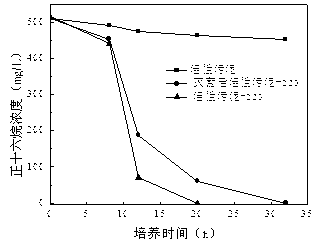Alkane degrading bacteria and application thereof
A technology of alkane degrading bacteria and Tsukamura bacterium is applied in the field of alkane degrading bacteria to achieve the effect of promoting biodegradation, increasing contact area and improving solubility
- Summary
- Abstract
- Description
- Claims
- Application Information
AI Technical Summary
Problems solved by technology
Method used
Image
Examples
Embodiment 1
[0014] Example 1: Tsukamura ( Tsukamurella sp . ) Separation and identification of C20 and its degradation performance on alkanes
[0015] The source of the bacteria was collected from the polluted soil in the sewage treatment station of Wuhan Branch of China Petroleum & Chemical Corporation, 2 to 4 cm from the surface of the oil-sludge mixture, which was dark brown.
[0016] Add 2 g of the collected soil sample to 100 mL of LB medium containing 200 mg / L n-hexadecane (peptone 1wt%, sodium chloride 1wt%, yeast extract 0.5 wt%), and add 15-20 The glass beads of bacteria were activated and cultured at 30°C and 150 r / min for 24 h. After standing still for 10 min, take 2 mL of culture medium and transfer to 100 mL of n-hexadecane inorganic salt culture concentration, acclimate to culture under the same conditions for 1-2 days, and transfer 4 times with gradient, in which the concentration of n-hexadecane is 200, 500 , 1000, 2000 mg / L. Gradually dilute the culture solution con...
Embodiment 2
[0020] Example 2: pH on Tsukamura ( Tsukamurella sp . ) Effect of C20 degradation performance
[0021] Inoculate the inorganic salt medium with 2vol% Tsukamurella ( Tsukamurella sp.) C20 bacterial suspension, adjust the inorganic salt medium to a different pH value (5.0 ~ 8.0), under the condition of the initial n-hexadecane concentration of 1000mg / L, cultivate for 36 hours, and measure the effect of pH value on the degradation of C20 The effect of n-hexadecane, the results are shown in Table 1. It is shown from Table 1 that in the range of pH 5.0-7.0, with the increase of pH in the medium, the ability of strain C20 to degrade alkanes increases, and when the pH is 7, the degradation ability is the strongest, and the degradation rate reaches 79.4%; when the pH is 8.0 When the pH was 6.0, the degradation rate dropped to 54.2%, but it reached 65.1% when the pH was 6.0, indicating that the strain C20 had a strong ability to degrade alkanes in a neutral or slightly acidic en...
Embodiment 3
[0025] Example 3: Tsukamura ( Tsukamurella sp . ) C20 degradation of diesel
[0026] 2vol% of Tsukamura ( Tsukamurella sp .) C20 was inoculated in the inorganic salt medium supplemented with 800mg / L diesel oil, cultured on a shaker at 37°C and 150r / min, cultured for 8, 12, 18 and 23 hours respectively, and samples were taken to analyze the strain’s resistance to diesel oil by gas chromatography. Degradation rate, while taking the sample without adding bacteria as the control. From Table 2 and figure 2 It can be seen that although in the initial 12 h, the volatilization loss of diesel components reached 14.2%, but adding the strain Tsukamurella sp. The degradation rate of C20 has reached 58.1%, indicating that the bacteria can degrade most of the alkanes in diesel. from figure 2 It can be seen that the bacteria are sensitive to alkane components (C 12 ~C 24 ) have a good degradation effect.
[0027] Table 2 Degradation effect of strain C20 on diesel
[0028] ...
PUM
 Login to View More
Login to View More Abstract
Description
Claims
Application Information
 Login to View More
Login to View More - R&D
- Intellectual Property
- Life Sciences
- Materials
- Tech Scout
- Unparalleled Data Quality
- Higher Quality Content
- 60% Fewer Hallucinations
Browse by: Latest US Patents, China's latest patents, Technical Efficacy Thesaurus, Application Domain, Technology Topic, Popular Technical Reports.
© 2025 PatSnap. All rights reserved.Legal|Privacy policy|Modern Slavery Act Transparency Statement|Sitemap|About US| Contact US: help@patsnap.com



